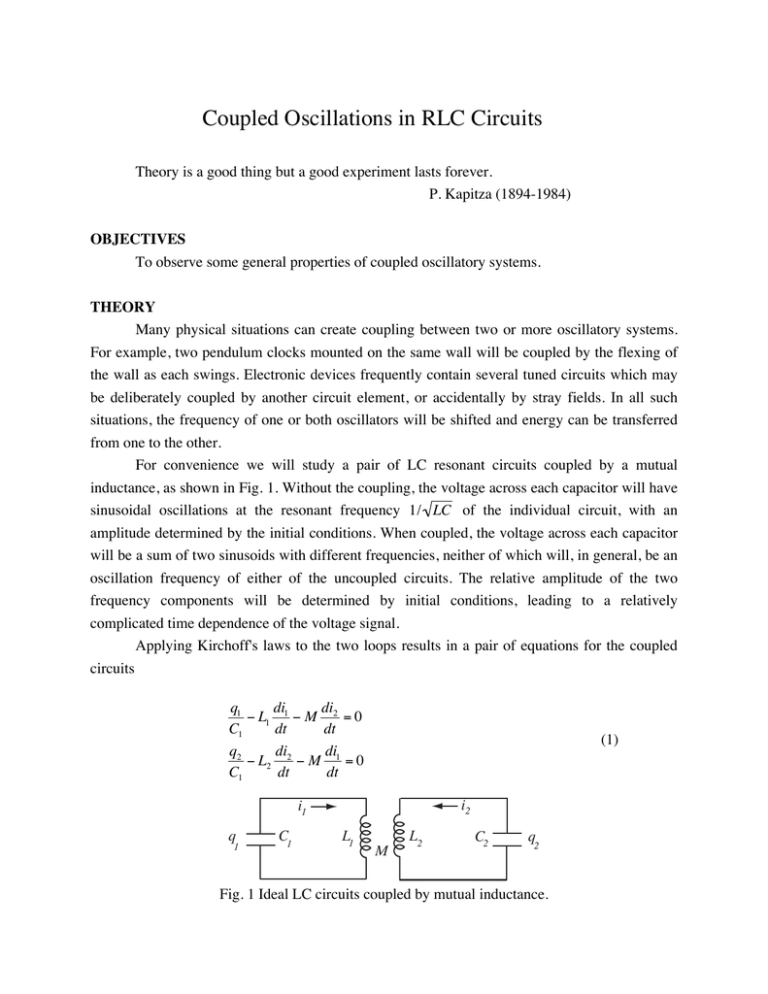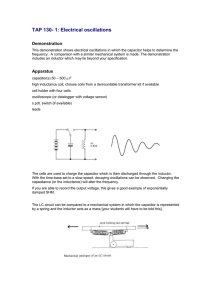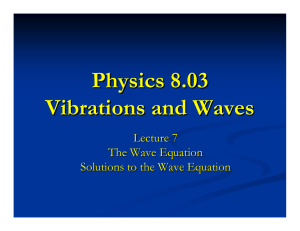Coupled Oscillations in RLC Circuits
advertisement

Coupled Oscillations in RLC Circuits Theory is a good thing but a good experiment lasts forever. P. Kapitza (1894-1984) OBJECTIVES To observe some general properties of coupled oscillatory systems. THEORY Many physical situations can create coupling between two or more oscillatory systems. For example, two pendulum clocks mounted on the same wall will be coupled by the flexing of the wall as each swings. Electronic devices frequently contain several tuned circuits which may be deliberately coupled by another circuit element, or accidentally by stray fields. In all such situations, the frequency of one or both oscillators will be shifted and energy can be transferred from one to the other. For convenience we will study a pair of LC resonant circuits coupled by a mutual inductance, as shown in Fig. 1. Without the coupling, the voltage across each capacitor will have sinusoidal oscillations at the resonant frequency 1/ LC of the individual circuit, with an amplitude determined by the initial conditions. When coupled, the voltage across each capacitor will be a sum of two sinusoids with different frequencies, neither of which will, in general, be an oscillation frequency of either of the uncoupled circuits. The relative amplitude of the two frequency components will be determined by initial conditions, leading to a relatively complicated time dependence of the voltage signal. Applying Kirchoff's laws to the two loops results in a pair of equations for the coupled circuits di di q1 − L1 1 − M 2 = 0 C1 dt dt q2 di di − L2 2 − M 1 = 0 C1 dt dt (1) i2 i1 q 1 C1 L1 M L2 C2 q 2 Fig. 1 Ideal LC circuits coupled by mutual inductance. We then use the fact that i1 = − dq1 dt i2 = − dq2 dt (2) and define some convenient parameters ω102 = 1/L1C1 m1 = M /L1 2 ω 20 = 1/L2C2 m2 = M /L2 (3) to obtain the coupled second order equations d 2q1 d 2q2 + m1 2 + ω102q1 = 0 2 dt dt 2 d q2 d 2q1 2 + m + ω 20 q2 = 0 2 dt 2 dt 2 (4) We assume a solution of the form q1 = A1 e iωt q2 = A2 e iωt (5) and substitute to get two algebraic equations in ω and A1, A2 ω 2 A1 + ω 2 m1 A2 − ω102 A1 = 0 2 ω 2 A2 + ω 2 m2 A1 − ω 20 A2 = 0 (6) The equations have solutions provided that ω is chosen to be 2 2 2 1/ 2 (ω102 + ω 20 ) ± [(ω102 + ω 20 ) − 4(1− m1m2 )ω102ω 20 ] ω = 2(1− m1m2 ) 2 ± (7) and that A1, A2 are related by ω102 − ω 2 A2 = A1 ω 2 m1 Physics 231 Coupled Oscillations (8) 2 The general solutions for q1, q2 are superpositions of terms corresponding to each of the allowed frequencies q1 = B1 e iω + t + B2 e−iω + t + B3 e iω − t + B4 e−iω − t (9) and a similar expression for q2 with coefficients that satisfy Eq. 8. To get a solution in terms of real cosine functions, let B1 = 12 D1e iφ1 B2 = 12 D1e−iφ1 B3 = 12 D2e iφ 2 B4 = 12 D2e−iφ 2 (10) ω102 − ω +2 ω102 − ω−2 cos( ω t + φ ) + D cos(ω− t + φ 2 ) + 1 2 ω +2 m1 ω−2 m1 (11) Substituting into Eq. 9, we finally get q1 = D1 cos(ω + t + φ1 ) + D2 cos(ω− t + φ 2 ) q2 = D1 This shows that both q1 and q2 are superpositions of two sine waves with amplitude and phase determined by the initial conditions. Some simplification is possible if we consider the important special case of identical oscillators, so that ω10 = ω20 = ω0 and m1 = m2 = m. Then ω +2 = ω 02 1− m ω−2 = ω 02 1+ m (12) which shows that the new oscillation frequencies are both shifted from ω0. For initial conditions such that capacitor C1 is fully charged, C2 has no charge, and the currents are zero, we find that D1 = D2 and φ1 = φ2. The resulting equal-amplitude sine waves will show a clear beat pattern at the difference frequency, and the beats on q1 and q2 will be phase shifted by π. It will be easy to test this prediction experimentally by observing the time dependence of q1 and q2. When the oscillators are not identical, oscillations will still occur at two distinct frequencies, but the amplitudes will not necessarily be equal, and beats may not be evident. These effects can be seen qualitatively in the time dependence but a mode plot, shown in Fig. 2, is a simpler way to verify the calculation. This is a plot of ω+ and ω- vs ω10 when ω20 is fixed, which shows how the coupled frequencies vary with the difference between the uncoupled frequencies. Note the odd fact that ω+ and ω- never become equal, a phenomenon called an avoided crossing which is characteristic of coupled linear systems. Physics 231 Coupled Oscillations 3 1.8 normalized mode frequencies 1.6 1.4 1.2 1.0 0.8 0.6 0.4 0.2 0.2 0.4 0.6 0.8 ω 1.0 10 /ω 1.2 1.4 1.6 1.8 20 Fig. 2 Mode plot for coupled oscillators. The dashed lines represent the uncoupled frequencies, while the solid lines are ω+ and ω- for the coupled system. All frequencies are scaled to ω20. EXPERIMENTAL PROCEDURE The time dependence of the coupled oscillations will be examined by plotting the voltages across C1 and C2 as a function of time during free oscillation. The mode plot will be constructed by driving one of the oscillators and looking for the frequencies that give maximum voltage across C1 or C2. The two methods require slightly different circuits and will be discussed separately. 1. Free oscillation Set up the circuit as shown in Fig. 3, using the large solenoids as L1 and L2. The solenoids should be aligned coaxially and as close together as possible to maximize coupling. Capacitor C1 is the 0.1 µF capacitor from the capacitor column on the patch board, and C2 is the 0.1 µF capacitor near the 3.3Ω resistor. Connections to the LabQuest interface should be made as shown, and the LoggerPro software started from Coupled.cmbl to configure the data acquisition. To measure the time dependence, set the switch to charge the capacitor, click on Collect and then flip the switch. If the mechanical switch contacts bounce you may see some anomalies Physics 231 Coupled Oscillations 4 Power Supply + LabQuest chan 1 + chan 2 + b a L2 L1 C1 chan 1 - C2 chan 2 - Fig. 3 Circuit for observing time dependence of q1 and q2. The power supply must be set to 10V to insure proper triggering of the LabQuest interface. at the start of the traces. Repeat the acquisition procedure until you get clear oscillations on both channels. The software will display the time dependence of both voltages and the frequency spectrum of the oscillations. According to the discussion above, the oscillations in this case should be described as the sum of two sine waves at slightly different frequencies, with damping due to the finite resistance in the circuit. The oscillation frequencies of V1 and V2 should be the same, as shown by the peaks in the respective FFT (fast Fourier transform) plots. To test this assertion more quantitatively, fit the data for V1 to the appropriate function from the Curve Fit menu. Is this an adequate description of the time dependence? What happens if you repeat the measurement with weaker coupling, achieved by moving the solenoids a few centimeters apart? How is this explained by Eq. 12? To examine the response of nonidentical oscillators, push the solenoids together to get maximum coupling and change C1 to get a different ω1. Using the FFT plots, compare the relative amplitudes of ω+ and ω- between the V1 and V2 signals for two or three ω1. Do you recognize any pattern of the relative amplitudes as you change ω1? 2. Driven oscillations Figure 4 shows the circuit for measuring the mode curve by determining the peak response frequencies. Sine-wave excitation is provided by the function generator, with the oscilloscope used as a voltmeter. If you slowly sweep the function generator through the frequency range around the resonances you will notice two relative maxima in V1 and V2, corresponding to ω+ and ω-. (The function generator reads frequency, not angular frequency, so it is easier to work with f+ and f- for this section.) Arrange the solenoids for maximum coupling and find f+ and f- using the available capacitor values on the board for C1 while keeping C2 at 0.1 µF. You also need to measure f1 for Physics 231 Coupled Oscillations 5 Oscilloscope Chan 2 Chan1 Red Red red 3.3 Ω black L2 L1 C1 Chan 1 Black C2 Chan 2 Black Fig. 4 Circuit for driving coupled LC circuits. Note the 3.3Ω resistor which decreases the effective output resistance of the function generator to minimize damping. External triggering from the TTL output of the function generator will give the most stable display and an accurate readout of the frequency on the scope screen. each C1 capacitor value when the solenoids are separated sufficiently that the coupling is negligible. Use these data to construct a mode plot. Does the result look like Fig. 2? Are the frequencies for the f1 = f2 case the same as those found by fitting the time dependence? If you are familiar with Matlab you can use the file mode_plot.m available on the PHYS 231 web page to plot your data and compare it to Eq. 7. In addition to the data above, you will also need f2 in the uncoupled case, to characterize that oscillator. The parameter m can be adjusted for best fit. REPORT Your report should include your fits of the time dependence data, the mode plot, and a discussion of your results. Physics 231 Coupled Oscillations 6


